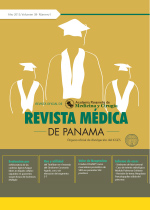Enfermedad de Kawasaki en Panamá
Autores/as
DOI:
https://doi.org/10.37980/im.journal.rmdp.2015174Resumen
Resumen:
La Enfermedad de Kawasaki (EK) es una vasculitis aguda, febril, sistémica, de etiología desconocida y que se presenta principalmente en niños menores de cinco (5) años de edad. Actualmente es la principal causa de cardiopatía adquirida en la infancia en países desarrollados. Objetivo: de este trabajo es conocer la evolución de un grupo de cuarenta (40) niños admitidos en el Hospital del Niño de Panamá con diagnóstico de Enfermedad de Kawasaki. Material y Métodos: Estudio descriptivo de una serie de casos de cuarenta (40) niños con EK admitidos entre junio 2011 y abril 2014 en el Hospital del Niño de Panamá. Resultados: El 68.2% eran varones con edades entre los 7meses y 6 años, el 100% presentó la forma clásica de la EK, con 7 casos de miocarditis y 3 casos con alteraciones coronarias. La EK fue diagnosticada con un promedio de 3.8 días del inicio del cuadro febril y el tratamiento resultó eficaz con desaparición de las alteraciones cardíacas en un periodo de 10 a 30 días.
Abstract
Kawasaki disease (KD) is an acute febrile and systemic vasculitis of unknown etiology. It affects primarily children younger than five years of age. It is the leading cause of acquired heart disease in children in developed countries. Objectives: to describe the evolution of 40 patients diagnosed with Kawasaki disease in Panama’s Hospital del Niño. Materials and Methods: descriptive study of 40 patients hospitalized between July 2011 and April 2014. Results: 68.2% were males, with ages between 7 months and 6 years. All the patients presented the typical form of KD, 7 cases with myocarditis and 3 cases with coronary affection. KD was diagnosed with an average of 3.8 days after the beginning of the fever and treatment was very effective with normalization of the cardiac alterations in a period of 10 to 30 days.
Kawasaki disease in panama
Abstract Kawasaki Disease (KD) is an acute, febrile, systemic vasculitis of unknown etiology that occurs mainly in children under five (5) years of age. It is currently the leading cause of acquired heart disease in children in developed countries. Objective: To describe the clinical and epidemiological characteristics and response to treatment of a number of patients admitted to the Children's Hospital of Panama diagnosed with KD and draw attention to the importance of early diagnosis gives the KD. Material and Methods: A descriptive study of a case series of forty (40) children with KD admitted between June 2011 and April 2014 in the Children's Hospital of Panama. Results: 68.2% were males between the ages of 7 months and 6 years, 100% presented the classic form of KD, with 7 cases of myocarditis and 3 patients with coronary abnormalities. KD was diagnosed with an average of 3.8 days of onset of fever and treatment was effective with disappearance of cardiac disorders in a period of 10-30 days. Conclusion: Most of the patients were male (68%) with a mean age of 2.39 years. They presented symptoms that were already known. Treatment Intravenous immunoglobulin was used to 2mg / kg and acetylsalicylic acid (ASA) in doses of 80 to 100 mg / kg / day. The importance of early diagnosis of the disease is emphasized.
Key words: Enfermedad de Kawasaki, vasculitis, aneurismas coronarios
Publicado
Número
Sección
Licencia
Derechos autoriales y de reproducibilidad. La Revista Médica de Panama es un ente académico, sin fines de lucro, que forma parte de la Academia Panameña de Medicina y Cirugía. Sus publicaciones son de tipo acceso gratuito de su contenido para uso individual y académico, sin restricción. Los derechos autoriales de cada artículo son retenidos por sus autores. Al Publicar en la Revista, el autor otorga Licencia permanente, exclusiva, e irrevocable a la Sociedad para la edición del manuscrito, y otorga a la empresa editorial, Infomedic International Licencia de uso de distribución, indexación y comercial exclusiva, permanente e irrevocable de su contenido y para la generación de productos y servicios derivados del mismo. En caso que el autor obtenga la licencia CC BY, el artículo y sus derivados son de libre acceso y distribución.






